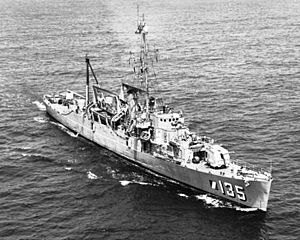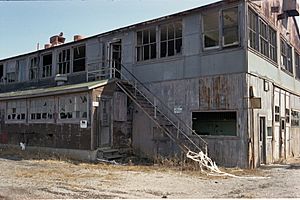Defoe Shipbuilding Company facts for kids
| Privately held company | |
| Industry | Shipbuilding and repair |
| Fate | Bankruptcy |
| Founded | 1905 |
| Defunct | 1976 |
| Headquarters |
,
United States
|
|
Key people
|
Harry J. Defoe |
| Services | Ship Repair |
| Owner | Harry J. Defoe and sons |
The Defoe Shipbuilding Company was an important company that built ships in Bay City, Michigan, USA. It started in 1905 and built many different kinds of boats. The company stopped working in 1976. This happened because they could not get new contracts from the United States Navy. Today, the land where the company once stood is being used for new homes and businesses. It is right on the Saginaw River.
Contents
Building Ships: The Early Years
Harry J. Defoe started the Defoe Boat and Motor Works in 1905. It was located on the Saginaw River in Bay City, Michigan. At first, the company built "knock-down" boats. These were boats that could be taken apart and put back together. They also built boats powered by gasoline for fun and for work.
In 1917, the company got its first big order from the United States Navy. They were asked to build five "Spent Torpedo Chasers." These boats helped find torpedoes after they were tested. In 1918, they built eight "steel Tumor Mine Planters." These ships helped place mines in the water.
From 1920 to 1939, Defoe built many ships for the government and for businesses. They also built fancy private yachts. This included patrol boats of different sizes for the United States Coast Guard.
A Special Yacht for Presidents
In 1931, Defoe built a special yacht called the Lenore. It was 92 feet long. This yacht was for Sewell Avery, who was a very important businessman. He named it after his daughter who had passed away.
During World War II, the U.S. Government took over the Lenore. It was used by the Coast Guard to patrol the coast. Later, in 1956, it became a special yacht for the President of the United States!
President Dwight D. Eisenhower called it the Barbara Anne. President John F. Kennedy called it the Honey Fitz. President Richard Nixon named it the Tricia. In 1941, the company changed its name to Defoe Shipbuilding Company.
Defoe's Role in World War II
During World War II, the Defoe Shipbuilding Company worked hard for the war effort. From 1939 to 1945, they built 154 ships! These included minesweepers, destroyer escorts, and high-speed transports. They also built many different kinds of landing craft. Even the Defoe family's own yacht was used by the U.S. Navy as a patrol boat.
The "Upside-Down and Roll-Over" Method
Defoe Shipbuilding came up with a clever way to build ships faster. They called it the "upside-down and roll-over" method. This meant they built the bottom part of the ship's hull (the main body) upside down. This made it much easier to do the welding. Welding is like gluing metal pieces together.
Once the hull was completely welded, they used large wheels to roll it right-side up. Then, they continued building the rest of the ship. This smart method allowed them to build one 173-foot patrol boat every single week!
Sadly, some of the ships built by Defoe were lost during the war. These included the destroyer escort Rich, the U.S. Coast Guard Cutter Escanaba, and the patrol craft PC-1129. A submarine chaser, PC 482, was sunk by a German U-boat in 1945. Defoe also built special refrigerated barges in 1945. These were like floating refrigerators for carrying food.
After World War II: New Ships and Repairs
After World War II, Defoe Shipbuilding continued to be busy. They built two very large ships for the Great Lakes. These ships were called bulk carriers. They also repaired many Great Lakes ships. This included updating their engines and changing them into "self-unloading" vessels. Self-unloaders can unload their own cargo.
In later years, Defoe built more ships for the U.S. Navy. This included destroyer escorts and guided missile destroyers. They also built three guided-missile destroyers for the Royal Australian Navy.
Defoe also built two important research vessels. These were the RV Melville and the RV Knorr. The Knorr is famous because it was the ship that found the wreck of the RMS Titanic!
Great Lakes Freighters
In the early 1950s, Defoe Shipbuilding built two huge Great Lakes freighters. These ships were designed to carry large amounts of cargo across the Great Lakes. One of these ships is still working on the Great Lakes today!
The Ojibway (Still Sailing!)
The Ojibway is a 642-foot long ship built by Defoe. It is still in service today! It is operated by a Canadian company. This ship was first named the Charles L. Hutchinson when it started sailing in 1952.
Over the years, the Ojibway has had several different names and owners. In 1961, it was sold to the Ford Motor Company and renamed the Ernest M. Breech. Later, it was sold again and became the Kinsman Independent.
In 2004, a Canadian company bought the ship. They fixed it up and gave it a new diesel engine. It returned to service in 2005 as the Voyageur Independent. Finally, in 2008, its current owner renamed it the Ojibway. It continues to carry cargo on the Great Lakes.
The Richard M. Marshall (Retired)
The second large Great Lakes freighter built by Defoe was the Richard M. Marshall. It was built in 1953. This ship was almost the same size as the Charles L. Hutchinson. It could carry about 18,500 tons of cargo.
The Richard M. Marshall also had several owners and names during its time. It was sold to the Ford Motor Company in 1966 and renamed the John Dykstra. Later, it was renamed the Benson Ford (2).
In 1985, the ship was taken out of service. Its final journey was in 1987. It was towed all the way to Brazil to be taken apart.
The End of an Era
The Defoe Shipbuilding Company closed its doors on December 31, 1976. This happened after their contracts with the Navy ended. In its final years, the company also worked on a few large projects for the Great Lakes.
One project was building the front part of a huge 1000-foot long tug and barge called the Presque Isle. This bow section was launched in 1972. It was then towed to another city to be joined with the rest of the barge. The Presque Isle was one of the biggest vessels on the Great Lakes at the time.
Defoe also converted two Great Lakes freighters. They changed the S/S Herbert C. Jackson into a self-unloader. They also changed the Richard J. Reiss from steam power to diesel power. All three of these vessels are still working on the Great Lakes today! The Richard J. Reiss is now called the M/V Manistee.
After the shipyard closed, the land became a scrap yard. Today, it is owned by OmniSource, Inc., another scrap company.
Images for kids











